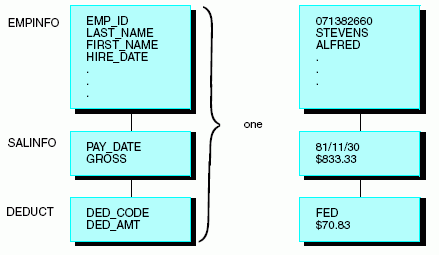Logical Independence: Multiple Paths
A group of segments that are related to each other as
a sequence of parent-child relationships, beginning with the root
segment and continuing down to a leaf, is called a path. Because
the path is a sequence of parent-child relationships, each segment
is logically dependent upon all of the segments higher in the path.
xUnderstanding a Single Path
In the following view of the EMPLOYEE data source, EMPINFO,
SALINFO, and DEDUCT form a path. An instance of DEDUCT (paycheck
deductions) can exist only if a related instance of SALINFO (the
paycheck) exists, and the instance of SALINFO can exist only if
a related instance of EMPINFO (the employee) exists.

xUnderstanding Multiple Paths
Consider the full EMPLOYEE structure,
which includes the EMPLOYEE data source and the JOBFILE and EDUCFILE
data sources that have been joined to it.
This is a multipath data structure. There
are several paths, each beginning with the root segment and ending
with a leaf. Every leaf segment is the end of a separate path. The following
diagram illustrates the concept of a multipath data structure.

xUnderstanding Logical Independence
The EMPLOYEE data structure
has six paths. The paths begin with the EMPINFO segment (the root),
and end with:
- The FUNDTRAN
segment.
- The SECSEG segment.
- The SKILLSEG
segment.
- The ADDRESS
segment.
- The DEDUCT segment.
- The COURSEG
segment.
Each path is logically independent of the others. For example,
an instance of DEDUCT is dependent upon its ancestor segment instances
SALINFO and EMPINFO, but the ADDRESS segment lies in a different
path, so DEDUCT is independent of ADDRESS.
This is because employee deductions are identified by the paycheck
from which they came, so deduction information can be entered into
the data source only if the paycheck from which the deduction was
made is entered first. However, deductions are not identified by
the employee address. An employee paycheck deduction can be entered
without the address being known, and conversely, the employee address
can be entered before any paychecks and deductions have been entered
into the data source.

